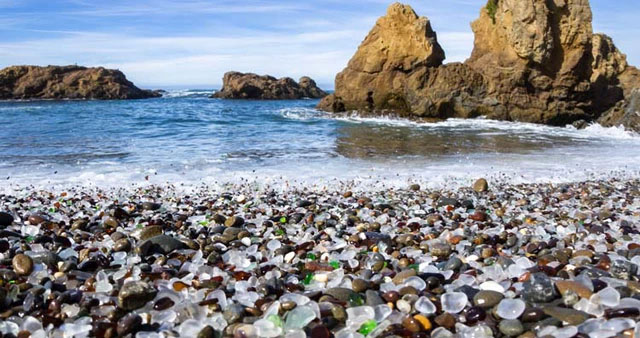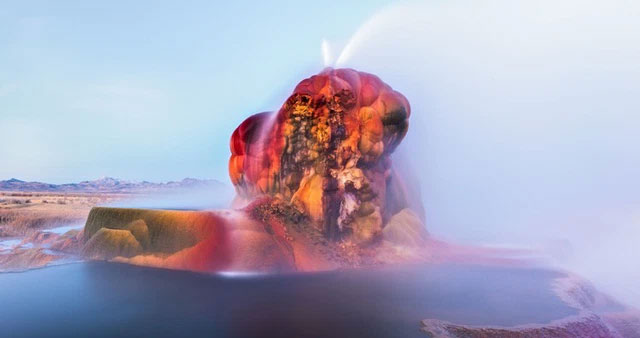Looking at them, they thought they were natural wonders, who would have thought they were completely man-made
1. Glass Beach, California
Located in Mackerricher State Park in Fort Bragg, Glass Beach in California was once a city dump. For about 60 years from 1900 to 1960, residents of California dumped trash including glass bottles, cans and other debris down cliffs and into the ocean below.

This coast has now become a popular tourist destination in the northern part of California.
However, this landfill was closed in 1967, and several cleanup programs were implemented to remove the waste. In which biodegradable waste will be left on the beach, while metal and other materials are discarded and sold as scrap. However, during the time it became a dumping ground, the waves crashed, breaking the ceramic bottles and jars and turning them into shards of smooth stone resembling glass.
Through years of renovation and cleaning, this beach has taken on a surprising new shape. This coast has now become a popular tourist destination in the northern part of California. You can even visit the 'sea glass' museum here.
It's illegal to pick up any piece of glass at the beach these days, but that still hasn't stopped tourists from bringing home small amounts of beach glass. Therefore, the glass reserve is constantly being depleted.
2. Fly Geyser, Nevada

This is a wonder created by chance.
Nevada's Fly Geyser is not a natural wonder, rather it is a wonder created by chance. This is an artificial geyser that appeared in 1916 on a piece of land owned by the "Burning Man Project". People here tried to drill a well in the hope that the desert would turn into fertile grassland, but they drilled a geyser.
However, this water source was quickly abandoned after people noticed that the water here was too hot. Then in 1964, the geyser reappeared after a geothermal power company drilled a test well on the same site.
After seeing that the water was still hot, they also decided to abandon this project, but the process of returning to the status quo was not done properly. Immediately after, the heat of geothermal caused the geyser to erupt at a height of 1.5m and pulled calcium carbonate deposits.
Over time, deposits of calcium carbonate in the water spewed out from the tap gave the mineral mound the distinctive shape it is today. Scientists say the outer color of the mineral mound is the result of a thermophilic algae, which thrive in hot, humid environments, and cyanobacteriae (bacteria that are green and blue in color).
3. Providence Canyon

This canyon is again the result of backward farming in the early 1800s.
Little Grand Canyon or Providence Canyon located in Atlanta, Georgia is an accidental man-made wonder. Although it is listed in the state's seven natural wonders, the canyon is in fact the result of backward farming in the early 1800s.
In the past, farmers cleared the wasteland by cutting down native trees there. This has resulted in soil erosion, surface loss. This land has been degraded due to the alternation between plantations and intercropping, thereby forming depressions. In 1850, the trenches here were only under 2 meters deep, but over time it has deepened to nearly 50 meters.
Although the canyon is actually a layer of degraded soil that has been eroded away, the area has become a hot spot for tourists today. Visitors come here to camp and hike along the trails that go around the belt and canyon. Geologists also regularly visit the site to study exposed sediments and formations.
4. Sidoarjo Mud Volcano, Indonesia

This volcano was created on a dangerous site in Sidoarjo.
The Sidoarjo Mud Volcano in Java, Indonesia is not a mud volcano that regularly erupts due to seismic activity but is the result of human greed. This volcano was created on a dangerous site in Sidoarjo by the Lapindo Brantas Company.
They have been warned many times to stop drilling and exploiting natural gas here, but in fact this company did not heed the warnings. As a result, in May 2006, their mining activities resulted in a 6.3 magnitude earthquake and several subsequent aftershocks.
After a few days, the borehole erupted, blowing mud into the air at an altitude of 200 meters. Since then, it has continuously erupted and spewed hot sulfuric mud into the atmosphere. Nearly 180,000 cubic meters of mud have been spewed out and this process is expected to continue for the next 30 years.
5. Big Hole, South Africa

In fact, this is one of the largest man-made holes in the world.
From the outside, it looks like a natural crater lake, but this is a giant man-made hole, and in fact it is one of the largest man-made holes in the world. gender. Big Hole in Africa is located in Kimberly, the largest diamond city in the world with the richest diamond mines on the planet. This pit was originally a diamond mining site.
It was discovered by accident in 1867 when 15 year old Erasmus Stephanus Jacobs found a small pebble on his family farm in De Kalk, near Hopetown. The pebble was then sent to a geologist in Grahamstown, Dr. William Atherstone, who concluded the pebble was a 21.25 carat diamond.
Then the diamond craze in Africa began and many people flocked to Kimberly, creating the largest manual "excavation" in the world. In 1914, mining was halted here because the pit had reached a depth of 1,083 meters. Before the Big Hole was closed, nearly 14.5 million diamonds had been unearthed since then. Today, the Big Hole is just a giant hole filled with water.
- 7 Wonders of the World ... computers
- 4 special wonders that everyone thought were fiction but turned out to exist really
- Marvel at the legends of 4 world natural wonders
- 11 natural wonders with surreal beauty
- The beauty of the only natural wonder seen from the universe
- Top natural wonders you may never know
- 7 ancient artificial wonders that challenge modern techniques
- 15 surprisingly beautiful natural wonders in America
- The world has 4 more natural heritages
- The Great Pyramid of Giza can be built on top of a huge natural hill
- 100 beautiful and spectacular places in the world (Part 2)
- 10 natural wonders should be enjoyed in life
 The 11 most unique public toilets in the world
The 11 most unique public toilets in the world Explore the ghost town in Namibia
Explore the ghost town in Namibia Rare historical moments are 'colored', giving us a clearer view of the past
Rare historical moments are 'colored', giving us a clearer view of the past The world famous ghost ship
The world famous ghost ship